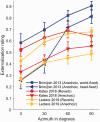Sound Externalization: A Review of Recent Research
- PMID: 32914708
- PMCID: PMC7488874
- DOI: 10.1177/2331216520948390
Sound Externalization: A Review of Recent Research
Abstract
Sound externalization, or the perception that a sound source is outside of the head, is an intriguing phenomenon that has long interested psychoacousticians. While previous reviews are available, the past few decades have produced a substantial amount of new data.In this review, we aim to synthesize those data and to summarize advances in our understanding of the phenomenon. We also discuss issues related to the definition and measurement of sound externalization and describe quantitative approaches that have been taken to predict the outcomes of externalization experiments. Last, sound externalization is of practical importance for many kinds of hearing technologies. Here, we touch on two examples, discussing the role of sound externalization in augmented/virtual reality systems and bringing attention to the somewhat overlooked issue of sound externalization in wearers of hearing aids.
Keywords: distal attribution; in-head localization; sound image externalization; spatial perception; virtual acoustics.
Figures




References
-
- Akeroyd M. A., Chambers J., Bullock D., Palmer A. R., Summerfield Q., Nelson P. A., Gatehouse S. (2007). The binaural performance of a cross-talk cancellation system with matched or mismatched setup and playback acoustics. Journal of the Acoustical Society of America, 121(2), 1056–1069. 10.1121/1.2404625 - DOI - PMC - PubMed
-
- Baumgartner R., Majdak P. (2020). Decision making in auditory externalization perception. bioRxiv. 10.1101/2020.04.30.068817 - DOI
-
- Baumgartner R., Reed D. K., Tóth B., Best V., Majdak P., Colburn H. S., Shinn-Cunningham B. (2017). Asymmetries in behavioral and neural responses to spectral cues demonstrate the generality of auditory looming bias. Proceedings of the National Academy of Sciences of the United States of America, 114(36), 9743–9748. 10.1073/pnas.1703247114 - DOI - PMC - PubMed
-
- Begault D. R., Wenzel E. M., Anderson M. R. (2001). Direct comparison of the impact of head-tracking, reverberation, and individualized head-related transfer functions on the spatial perception of a virtual speech source. Journal of the Audio Engineering Society, 49(10), 904–916. - PubMed
Publication types
MeSH terms
Grants and funding
LinkOut - more resources
Full Text Sources
Other Literature Sources
Medical
Miscellaneous

